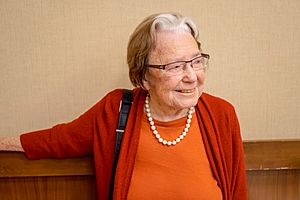Myriam Sarachik facts for kids
Quick facts for kids
Myriam Sarachik
|
|
|---|---|

Sarachik in 2019
|
|
| Born |
Myriam Paula Morgenstein
August 8, 1933 Antwerp, Belgium
|
| Died | October 7, 2021 (aged 88) Manhattan, New York, U.S.
|
| Alma mater | Columbia University (M.S., 1957; Ph.D, 1960, physics) Barnard College (B.A., 1954, physics) |
| Scientific career | |
| Fields | Physics |
| Institutions | City College of New York |
| Thesis | Penetration of magnetic fields through superconducting lead films (1960) |
| Doctoral advisor | Richard Garwin |
Myriam Paula Sarachik (August 8, 1933 – October 7, 2021) was an American physicist born in Belgium. She was known for her work in experimental physics. This means she did experiments to understand how the world works. From 1996, she was a special professor of physics at the City College of New York.
Contents
Early Life and Education
Myriam Paula Morgenstein was born on August 8, 1933, in Antwerp, Belgium. Her parents were Sarah and Schloimo Morgenstein. They were Orthodox Jewish, and had to leave Belgium in 1940. This was because of the German occupation of Belgium during World War II.
In 1941, her family tried to cross the border from France into Spain. They were caught and held in a camp called Merignac. Later, they were moved to another camp near Tours. But they managed to escape that same year. They were secretly taken across the border to a safer part of France.
Life as a Refugee
Myriam spent the next five and a half years in Cuba as a refugee. There, she went to school and learned both Spanish and English. In 1947, Myriam and her family got visas to enter the United States. They then moved to New York City.
She finished high school at the Bronx High School of Science in 1950. That same year, she started studying at Barnard College. Myriam earned her bachelor's degree (B.A.) in 1954.
University Studies
She continued her studies at Columbia University. She received her master's degree (M.S.) in 1957. Then, she earned her Ph.D. (doctorate degree) in 1960. Her Ph.D. advisor was Richard Garwin.
For her Ph.D. research, she studied how magnetic fields pass through special films. These films were made of a material called a Type-I superconductor. She published her research findings in important science journals.
Academic Career and Research
In the 1960s, Myriam Sarachik worked at Bell Labs. Her experiments there provided the first proof of something called the Kondo effect. This effect describes how electrons behave in certain metals at very cold temperatures.
Even though some people suggested she become a housewife, Myriam chose a different path. In 1964, she joined the physics department at the City College of New York. She started as an assistant professor.
Rising Through the Ranks
She quickly moved up in her career. In 1967, she became an associate professor. By 1971, she was a full professor. In 1996, the City College of New York honored her. They named her a distinguished professor of physics.
Sarachik's main work was in a field called low-temperature condensed matter physics. She studied tiny magnets made of molecules, called molecular nanomagnets. She also looked at strange behaviors in very thin layers of electrons.
Key Research Areas
Some of her research tried to figure out when a material that usually doesn't conduct electricity (an insulator) can become a conductor. These experiments had to be done at temperatures close to absolute zero. This is the coldest possible temperature.
Myriam Sarachik also researched how heat and electricity move through semiconductors. She also studied quantum tunnelling. This is a strange quantum effect where particles can pass through barriers.
Leadership and Recognition
Myriam Sarachik was a leader in the physics community. In 2003, she was the president of the American Physical Society (APS). This is a major organization for physicists.
In 2005, she received the Oliver E. Buckley Condensed Matter Prize. This is a very important award in her field. In 2008, she was chosen to be on the governing council of the National Academy of Sciences.
In 2020, Sarachik received the APS Medal for Exceptional Achievement in Research. This was for her important work on how electrons move in solids. It also recognized her work on molecular magnetism.
Defending Human Rights
Myriam Sarachik was also very active in defending the human rights of scientists. She was a member and chair of a committee for international freedom of scientists at the APS. She also worked with the Human Rights of Scientists Committee of the New York Academy of Sciences. She was a board member of the Committee of Concerned Scientists.
Honors and Awards
Myriam Sarachik received many honors and awards:
- Member, National Academy of Sciences (elected 1994)
- Member, American Academy of Arts and Sciences (elected 1999)
- Fellow, American Physical Society
- Fellow, New York Academy of Sciences
- Fellow, American Association for the Advancement of Science
- Recipient, 1995 NYC Mayor's Award for Excellence in Mathematical, Physical, and Engineering Sciences
- Recipient, 2004 Sloan Public Service Award from the Fund for the City of New York
- Recipient, 2005 L'Oréal/UNESCO For Women in Science Laureate for North America
- Recipient, 2005 APS Oliver E. Buckley Prize in Condensed Matter Physics
- Recipient, 2006 Honorary Doctor of Science degree from Amherst College
- Recipient, 2020 APS Medal for Exceptional Achievement in Research
Personal Life
In 1954, Myriam married Philip Sarachik. He was a professor of electrical engineering at New York University. They had two children together.
Myriam Sarachik passed away on October 7, 2021, in Manhattan. She was 88 years old.
See also
 In Spanish: Myriam Sarachik para niños
In Spanish: Myriam Sarachik para niños

